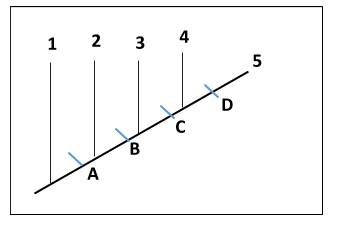
A student is comparing traits for five related bird species. They make a chart and record data for four different traits. They then use the chart to make a cladogram showing their hypothesized relationships between the species.
1 2 3 4 5 Head Size 20 cm 20 cm 20 cm 20 cm 20 cm Beak Color Black Blue Blue Black Black Eye Color Black Black Red Red Red Eye Number 2 2 2 2 3

What occurred at point C on the cladogram?
A. Head size increased.
B. Red eyes developed.
C. The beak color of the common ancestor of Species 4 and 5 changed from blue to black.
D. The descendants of Species 3 diverged to become Species 4 and Species 5.
| 1 | 2 | 3 | 4 | 5 | |
| Head Size | 20 cm | 20 cm | 20 cm | 20 cm | 20 cm |
| Beak Color | Black | Blue | Blue | Black | Black |
| Eye Color | Black | Black | Red | Red | Red |
| Eye Number | 2 | 2 | 2 | 2 | 3 |

Answer
556.2k+ views
Hint:-A cladogram is a diagram used to display relations between species in cladistics. However a cladogram is not an evolutionary tree since it does not demonstrate how descendants are bound to ancestors, nor does it show how much they have evolved, meaning that se
Complete Answer:-A cladogram uses lines that branch out into a clade, a group of species with a last common ancestor, in various directions. Cladograms have several forms, but they all have lines that branch out from other lines. It is possible to follow the lines back to where they branch out. These branching off points represent a hypothetical ancestor (not an individual entity) that can be inferred from the above to show the characteristics shared between the terminal taxa. This hypothetical ancestor could then include clues regarding the order of evolution of different traits, adaptation, and other ancestor evolutionary narratives.
In the figure given above, the other features at point C do not change other than the beak colour that changes from Blue to Black. Therefore the right answer is option C, i.e “The beak colour of the common ancestor of Species 4 and 5 changed from blue to black”.
Note:- The DNA and RNA sequencing data and computational phylogenetics are now very widely used in the generation of cladograms, either on their own or in conjunction with morphology, whereas historically such cladograms were mostly created based on morphological characters.
Complete Answer:-A cladogram uses lines that branch out into a clade, a group of species with a last common ancestor, in various directions. Cladograms have several forms, but they all have lines that branch out from other lines. It is possible to follow the lines back to where they branch out. These branching off points represent a hypothetical ancestor (not an individual entity) that can be inferred from the above to show the characteristics shared between the terminal taxa. This hypothetical ancestor could then include clues regarding the order of evolution of different traits, adaptation, and other ancestor evolutionary narratives.
In the figure given above, the other features at point C do not change other than the beak colour that changes from Blue to Black. Therefore the right answer is option C, i.e “The beak colour of the common ancestor of Species 4 and 5 changed from blue to black”.
Note:- The DNA and RNA sequencing data and computational phylogenetics are now very widely used in the generation of cladograms, either on their own or in conjunction with morphology, whereas historically such cladograms were mostly created based on morphological characters.
Recently Updated Pages
A man running at a speed 5 ms is viewed in the side class 12 physics CBSE

The number of solutions in x in 02pi for which sqrt class 12 maths CBSE

State and explain Hardy Weinbergs Principle class 12 biology CBSE

Write any two methods of preparation of phenol Give class 12 chemistry CBSE

Which of the following statements is wrong a Amnion class 12 biology CBSE

Differentiate between action potential and resting class 12 biology CBSE

Trending doubts
What are the major means of transport Explain each class 12 social science CBSE

Which are the Top 10 Largest Countries of the World?

Draw a labelled sketch of the human eye class 12 physics CBSE

Explain sex determination in humans with line diag class 12 biology CBSE

Explain sex determination in humans with the help of class 12 biology CBSE

Differentiate between homogeneous and heterogeneous class 12 chemistry CBSE




